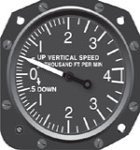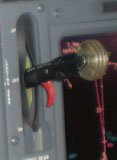Gear, Flaps Up
The Gear,Flaps Up evolution is one of the most coordinated crew actions that take place during your flight. In this example, the Captain is making the takeoff and departure. As the Captain pulls the yoke back at rotate speed, the nose of your aircraft rises and you are airborne!
Both pilots will be looking at the VSI (Vertical Speed Indicator) instrument. When the needle indicates a movement upward (positive rate-of-climb), the either pilot will call out "Positive Rate, Gear Up".
Upon this callout, the First Officer will raise the landing gear handle to the up position. In most aircraft, the main landing gear and nosewheel come up at the same time.
As the aircraft accelerates there are certain maneuvering speeds that are set for flap retraction. These are different for each aircraft and even each aircraft model. They are also dependent on the weight of the aircraft.
On takeoff, flaps can be set at different settings (more on this in a later section!). This will also determine when they are retracted. For example, if a Boeing 737 takes off at flaps 5 setting, then as the aircraft accelerates through V2 (speed for the best angle of climb) + 15 knots then the flaps will be selected to flaps 1. For example, if V2 was say, 145 knots, then V2+15 would equal 160 knots. The flaps would be positioned at flaps 1 setting.
Now as the aircraft accelerates through 190 to 200 knots (219 to 230 miles per hour), the flaps will be selected to the UP position. This means that they will be all the way up. Your aircraft is now in a climb configuration and drag is minimized. Your aircraft climbs to altitude, usually at a speed that is most efficient in terms of fuel burned.



VSI (Vertical Speed Indicator) “Positive Rate”
Gear Handle
Flap Handle
Gear, Flaps Up back to My Airline Flight